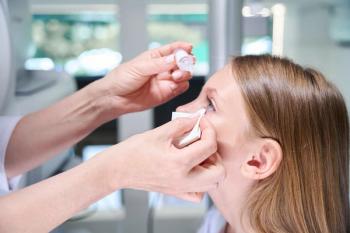
- August digital edition 2020
- Volume 12
- Issue 8
3 steps to managing scleral lens patients with allergies
Allergy sufferers are more likely to develop ocular symptoms with scleral lens wear.
Contact lens discomfort is common during allergy season, especially with scleral lens wearers. Successful scleral lens wear depends on both proper management and understanding of the pathophysiology behind a patient’s symptoms, in order to develop an ideal treatment which provides all-day comfort and clarity as well as minimizes midday fogging and surface deposits.
SCLERAL CONTACT LENSES have been around since the late 1800s;1 however, they have been used more frequently in the last decade due to enhanced technology and fitting capabilities. Corneal irregularity persists as their main indication followed by ocular surface disease (OSD) and uncomplicated refractive error.2
It is well known that patients with corneal ectasia often suffer from ocular or systemic allergy.3 This can create a challenge for the scleral lens practitioner and wearer, because wearers may experience contact lens intolerance, fogging, surface deposits, and other concerns. It is important to remember many of these patients rely on scleral contact lenses to provide functional vision.
The savvy practitioner will face these challenges and provide wearers with clear and comfortable vision for years. Scleral lens sucsess comes down to understanding a patient’s condition, establishing realistic expectations and starting a diligent treatment plan from the start.
This article discusses 3 simple steps to successfully manage scleral lens patients who suffer from ocular allergies.
Step 1: Understand the allergy
Various forms of ocular allergy and ocular irritants that mimick allergies exist. Successful scleral lens wear depends on both proper management and understanding of the pathophysiology behind a patient’s symptoms.
IgE-mediated
Seasonal (SAC) and perennial (PAC) are the most common types of allergic conjunctivitis. Their pathophysiology is a classic immunoglobulin E-mediated (IgE) hypersensitivity response to an allergen. SAC is caused by airborne pollen and presents most often in spring and fall months. PAC is caused by exposure to allergens such as cigarette smoke, pet dander, and dust mites. Therefore, it can be present year-round. The most common complaint associated with PAC is itching. PAC is confirmed by presence of fine papillae of the tarsal conjunctiva, hyperemia, and chemosis.4
IgE and non-IgE mediated
Atopic (AKC) and vernal keratoconjunctivitis (VKC) are rarer and more severe forms of ocular allergy than SAC and PAC. Their pathophysiology is less known; however, they are presumed to consist of both IgE and non-IgE immune mechanisms. AKC is associated with eyelid dermatitis, most often eczematous. VKC classically presents with cobblestone papillae and/or eosinophilic Horner-Trantas dots along the limbus. Both conditions present with significant symptoms of intense itching and photophobia and often involve the cornea.4
Mechanical ocular irritants
Giant papillary conjunctivitis (GPC) is not a true allergy in the sense that it is IgE-mediated. Rather, this allergy is due to an inert substance that causes chronic irritation to the upper tarsal conjunctiva. Such substances include contact lenses, limbal sutures, limbal dermoids, and ocular prostheses. It is thought that poor edge design and protein build-up are the main culprits of GPC in contact lens wearers.4
A common condition often overlooked as cause for ocular irritation is floppy eyelid syndrome (FES). FES is similar to GPC in the sense that it is not a true allergy. It is characterized by hyperlaxity and chronic palpebral conjunctivitis of the upper eyelids. It has a strong association with sleep apnea and keratoconus. Treatments includes aggressive lubrication, nighttime eye shield, sleeping upright as opposed to side sleeping, and continuous positive airway pressure (CPAP) devices when sleep apnea is present.5
Step 2: Set the stage for success
Scleral lens wearers who also suffer from ocular allergies or chronic ocular irritation will be burdened with a strict must follow more specific guidelines as compared to wearers who do not have the condition. It is crucial that the practitioner establish an understanding of this with the patient at the initial consultation.
Case history
This is the practitioner’s opportunity to understand individual needs and adjust scleral lens fit as needed. Does the patient have a history of contact lens intolerance or dropout? Sleep apnea? Obesity? Seasonal allergies? Dermatological conditions such as eczema?
Slit-lamp examination
The importance of eyelid eversion, despite discomfort caused to the patient, cannot be overly emphasized. It is best to evaluate with both white light and fluorescein with the cobalt blue filter. The white light allows evaluation of hyperemia and stringy mucous whereas the fluorescein highlights the palpebral conjunctival contour and extent of disease.
Establish realistic expectations
Scleral lens wearers must be committed to a strict disinfection and hygiene protocol to prevent infection, provide maximal comfort, and optimize vision.
Midday fogging (MDF) is a common phenomenon and caused by accumulation of particulate matter between the scleral lens and cornea.6 Its exact mechanism is unknown, however, recent research indicates inflammation plays a significant role.7 Some theories of how to combat MDF include minimize central clearance to 200 µm, create a smooth landing zone with toric haptics, and recommend a viscous tear reservoir (Refresh Celluvisc, Allergan) as opposed to traditional preservative-free saline. Patients may still have to remove, rinse, and reinsert the scleral lens with fresh saline to resolve fogged vision.
Step 3: Maximize comfort and clarity
Although it can be cumbersome, it is important to treat ocular allergy to ensure successful scleral lens wear on a long-term basis.
Non-pharmacologic intervention
Allergen avoidance is encouraged when feasible. Cool compresses can be used in acute situations or to mitigate the sensation of rubbing one’s eyes. Preservative-free, artificial tears help to lubricate the ocular surface and flush inciting allergens.4
Pharmacologic intervention
Medicinal treatment depends on the type and severity of the allergy. SAC and PAC can be treated as needed with topical antihistamine, mast-cell stabilizers, or a combination of both. A non-steroidal anti-inflammatory (NSAID) or soft steroid may be indicated in the moderate to severe acute setting. AKC and VKC typically require a steroid given the level of inflammation. Topical immunomodulators such as cyclosporine (Restasis, Allergan; Cequa, Sun Pharma) and tacrolimus (Protopic, Astellas) can be considered longterm to maintain remission.4
Reduce inflammation
Concomitant dry eye and other ocular surface diseases should be treated. Patients should be aware of the pro-inflammatory effects of preservatives such as bBenzalkonium chloride (BAK) and advised to find alternatives, when possible.8
Scleral lens fit
Although challenging, the art of creating the “perfect” scleral lens fit for allergy sufferers can be achieved to provide all-day comfort and clarity as well as minimize MDF and surface deposits. To find the best scleral lens fit for an allergy patient, follow these steps:
• Create a seamless edge that is free of lift. Given knowledge of scleral toricity, this often requires use of toric peripheral curves.
• Optimize surface wettability with a lower Dk material9 and HydraPEG (Tangible Sciences) coating. Caution the patient while handling a lens with this coating because it can slip.
• Consider a fluid reservoir with preservative-free, artificial tears or a more viscous option.
Lens care and hygiene
Hydrogen peroxide disinfection systems are the most commonly prescribed method for scleral lens wearers,2 however it is crucial to recommend for patients suffering from allergies. Research shows significant reduction in eyelid papillae and improvement in symptoms after 90 days of use versus preservative multi-purpose solution.10
ODs should emphasize the step of rubbing contact lenses before overnight storage. It has been shown that frictional force effectively removes microbes, surface deposits, and allergens.11
Collaboration
Do not be afraid to co-manage with an appropriate sub-specialist. A workup and possible immunotherapy treatment by an allergist may be indicated in chronic allergy cases. A dermatologist is often helpful in cases of AKC. Referral to an oculoplastic surgeon may be necessary in FES.
Scleral lens wear can be a challenge for allergy sufferers; however, clear and comfortable vision is achievable for those who rely on these lenses. It is crucial that ODs prepare themselves and stay updated on new technology and research in order to be successful.
References
1. Jedlicka J. Scleral Lenses: Past and Present. CL Spectrum. Available at: . https://www.clspectrum.com/supplements/2016/october-2016/scleral-lenses-understanding-applications-and-max/scleral-lenses-past-and-present. Accessed 7/21/20.
2. Nau CB, Harthan J, Shorter E, Barr J, Nau A, Chimato NT, Hodge DO, Schornack MM. Demographic Characteristics and Prescribing Patterns of Scleral Lens Fitters: The SCOPE Study. Eye Contact Lens. 2018 Sep;44 Suppl 1:S265-S272.
3. Sharma N, Rao K, Maharana PK, Vajpayee RB. Ocular Allergy and Keratoconus. Indian J Ophthalmology. 2013 Aug;61(8):407-409.
4. La Rosa M, Lionetti E, Reibaldi M, Russo A, Longo A, Leonardi S, Tomarchio S, Avitabile, T, Reibaldi A. Allergic conjunctivitis: a comprehensive review of the literature. Ital J Pediatr. 2013 Mar 14;39:18.
5. Salinas R, Puig M, Fry CL, Johnson DA, Kheirkhah A. Floppy eyelid syndrome: A comprehensive review. Ocul Surf. 2020 Jan;18(1):31-39.
6. Postkinoff CK, Pucker AD, Laurent J, Huisingh C, McGwin G, Nichols JJ. Identification of Leukocytes Associated with MiddDay Fogging in the Post-Lens Tear Film of Scleral Contact Lens Wearers. Invest Ophthalmol Vis Sci. 2019 Jan 2;60(1):226-233.
7. Schornack MM, Fogt J, Harthan J, Nau CB, Nau A, Cao D, Shorter E. Factors associated with patient-reported midday fogging in established scleral lens wearers. Cont Lens Anterior Eye. 2020 Mar 20. DOI: https://doi.org/10.1016/j.clae.2020.03.005.
8. Coroi MC, Bungau S, Tit M. Preservatives from the Eye Drops and the Ocular Surface. RomOphthalmol. Jan-Mar 2015;59(1):2-5.
9. Bennett ES, Henry VA. Clinical Manual of Contact Lenses, 4th ed. Philadelphia: Lippincott Williams and Wilkins; 2013.
10. Lievens CW, Kannarr S, Zoota L, Lemp J. Lid Papillae Improvement with Hydrogen Peroxide Lens Care Solution Use. Optom Visi Sci. 2016 Aug;93(8):933-942.
Articles in this issue
over 5 years ago
3 reasons to fit kids with contact lensesover 5 years ago
Dry eye intranasal spray stimulates the trigeminal nervesover 5 years ago
Technology for optometry post COVID-19over 5 years ago
5 essential truths to treating dry eye diseaseover 5 years ago
How the tear film affects IOL measurementsover 5 years ago
The evolving standard of care in AMDover 5 years ago
Optimizing ocular blood flow in glaucoma managementover 5 years ago
The time is now for optometry and telehealthover 5 years ago
IPL: The science of comfort and safetyNewsletter
Want more insights like this? Subscribe to Optometry Times and get clinical pearls and practice tips delivered straight to your inbox.














































.png)


